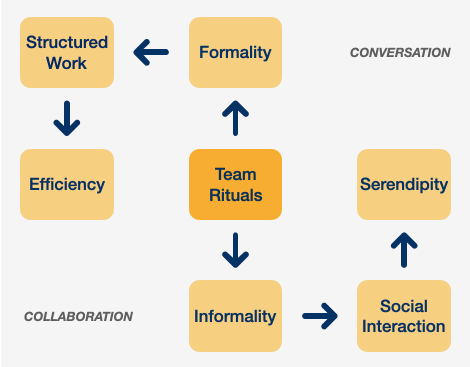One of the most acutely-felt shortcomings of remote working is the lack of serendipitous human interaction, from overhearing (and perhaps joining) an interesting conversation over coffee, to making weekend hackathon connections, or even striking up an airport conversation with someone who, it turns out, works for the company you’re on your way to visit. Speaking of which, if you ever needed to find out your risk of contracting COVID-19 at a business event, Joshua Weitz and his team at GeorgiaTech have released a handy planning tool to help you do just that.
Arguably, the need for in-person human contact is most acutely felt in those two mainstays of the consulting industry: events and workshops. There are software options of varying quality for doing both virtually, but the over-engineered, pre-planned need of making these work in the absence of face-to-face social signals and in-person camaraderie makes the online version both unsatisfying and somewhat unforgiving.
Is this a chance to make conferences better?
The events and conferences industry, in particular, is in desperate need of solutions right now. Not only is the industry in tatters, but – more tellingly – the lack of face-to-face events has exposed one of the fundamental flaws in this business model, i.e. the lack of value that most events actually deliver to its (often fee-paying) attendees. Event organisers aside, are any of us actually poorer for not traipsing to hotels to sit in large rooms listening to endless slide shows, sneaking out to take calls, and striking up conversations with people who were sent there by their boss, because they couldn’t make it?
We’ve come across some good remote event software recently, like Remo and Proske, which take care of the presentations, commenting and virtual networking elements as well as is probably possible in a virtual setting. But the real let-down, both in real-world conferences and their virtual counterparts, is the lack of any credible way to follow up on the contacts made, the plans hatched, the ideas generated in those settings. As Bill Gates said recently,
“More could be done on the software side to allow for serendipitous run-ins after meetings”
Could he be thinking about a new use case for LinkedIn, perhaps? The user experience for exchanging contacts and following up from events could definitely be improved, so here’s hoping.
We’re still a long way from real co-creation
Regarding workshops, we were lucky to have developed some strong business relationships before the current pandemic struck, which has helped to smooth our path in continuing to deliver virtual learning sessions and project workshops with our clients. In several cases, they have spread what we have taught them about running virtual workshops internally, which is encouraging to see. But starting projects with new clients – especially if their level of digital maturity is not very high – will undoubtedly remain a challenge in the coming months, even for companies whose core business is to enable new ways of working and collaboration – none of which is made any easier by the poor user experience and clunky functionality of market-leading enterprise collaboration software.
Taking Microsoft Teams as an entirely random example, organising anything but the most basic video-conference calls has not been easy in the past 9 months. With no breakout room facilities, workshop facilitators are stuck with having to create Teams channels before a session, which is laborious but also assumes knowing in advance which participant to go into which channel, with no flexibility to change these pre-allocations in real-time, or a simple way to then reconvene from the channel discussions to a plenary session.
It’s no wonder, then, that Microsoft have been rushing to develop the new Teams Breakout Rooms functionality to plug this gap, with general release – after a few false starts – now assumed to take place as early as December 2020. You can follow this link for a very good in-depth review of what to expect from Matt Wade (of Periodic Table of Office 365 fame).
Let’s hope that improvements to the Teams Whiteboard, which is basic and slow to use, are also in the works. Just as it’s hard for Microsoft to compete on the overall quality of the user experience of point solutions like Zoom and Google Meet for virtual meeting , or Slack (currently the target for a possible Salesforce acquisition) for informal project collaboration, there is a plethora of much better white-boarding software on the market, each of which can make the workshop experience better than is currently possible within Teams.
We have seen tools like Visme, Miro, Mural, Mentimeter, Conceptboard and Stormboard in use among our clients recently, but there are plenty more out there.
Could rituals close the productivity / serendipity rift?
At the heart of these challenges is a remote working paradox, succintly expressed by Michael Y. Lee and Koen Veltman of INSEAD in their recent study of why the growth of remote working driven by the COVID-19 pandemic has either brought colleagues closer, or driven them apart:
“While 45 percent of the respondents said their team’s level of connectedness had declined since Covid-19, nearly one-third (31 percent) said it had improved.”
The authors list three key reasons driving these divergent dynamics: the ability to harness new technologies, designing rituals for the new remote format, and showing compassion and care.
The most fascinating of these – and one that resonates strongly with some current client work – is the question of rituals. Teams who have struggled with remote working since COVID-19 have been those who have relied on informal connections to make sense of their work environment and get things done, whereas teams that have implemented good working rituals (possibly including those who were already working in a digital way) have thrived and become more efficient.
This is all very well if your only focus is productivity (which as I’ve argued previously comes at a risk of burning out). But what if rituals could also help us solve the serendipity challenge? If we designed rituals to not only deliver work, but also create informal social spaces, we might be able to better engage those who are struggling. I’ve tried to summarise this here:

It might require a fairly large group for this to work, and it’s definitely not as good as sharing drinks in a bar, but it might be worth a try.
NOTE: Post*Shift has no commercial connection whatsoever with any of the software tools linked from this post, which are shared for information only. No endorsement is intended or implied.

